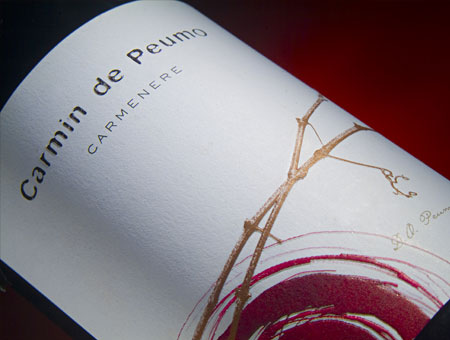 Terroir is one of those ideas that is thrown around a lot as a buzz word in the wine industry. Depending on who it is bringing it up there can be a bit of controversy surrounding it. And while it may seem a little out there to some folks to think that Cabernet Sauvignon for example planted in a specific spot can be imbued with very different characteristics than a Cabernet Sauvignon planted a few hundred feet away, the truth is in the bottle. All one really needs to better understand the concept of Terroir is a taste, once you’ve experienced it first hand it’s easier to believe. Of course it’s a sliding scale and not every wine or more specifically every place will impart that. Furthermore some wines are made in such a style that their Terroir ends up being masked. That’s a different part of the subject for another day. This is about wines that do show their sense of place. I attended Vinos De Terroir hosted by Wines of Chile. The concept was a focused look at 10 great examples of Terroir driven wines from Chile. The event took place at Colicchio & Sons, hosted by Pedro Parra PhD and Terroir expert, author Mark Oldman and Sandy Block Master of Wine. Over the course of a couple of hours we took a long hard look at 10 wines in a classroom style format. After that we sat down for lunch and the same 10 wines were available to taste with our meal. These wines were uniformly excellent examples of Terroir. What follows are some reflections on the ones that were my personal favorites.
The one white wine from this particular tasting was the Casa Marín 2011 Cipress Vineyard Sauvignon Blanc. This is a 100% Varietal wine sourced from a vineyard at the very top of a hillside. The fruit came from 6 blocks within this specific vineyard. It sits 4 km from the ocean and is one of the most extreme plantings in all of Chile. The conditions are very windy and result in low yields. This wine has a suggested retail price of $28. There’s a huge burst of lemon characteristics that explode from this Sauvignon Blanc. They’re joined by bits of green herb to form a pleasing nose. Citrus, tropical fruits and lots of mineral notes are all part of the complex and layered palate which has excellent weight. Lemon curd, bits of candied tropical fruits and a bevy of spice notes are part of the persistent finish. This Sauvignon Blanc is a real knockout, impressive in every way. It’s well worth making a special effort to locate. I can't overstate how phenomenal this Sauvignon Blanc is, grab some and taste its excellence for yourself.
Terroir is one of those ideas that is thrown around a lot as a buzz word in the wine industry. Depending on who it is bringing it up there can be a bit of controversy surrounding it. And while it may seem a little out there to some folks to think that Cabernet Sauvignon for example planted in a specific spot can be imbued with very different characteristics than a Cabernet Sauvignon planted a few hundred feet away, the truth is in the bottle. All one really needs to better understand the concept of Terroir is a taste, once you’ve experienced it first hand it’s easier to believe. Of course it’s a sliding scale and not every wine or more specifically every place will impart that. Furthermore some wines are made in such a style that their Terroir ends up being masked. That’s a different part of the subject for another day. This is about wines that do show their sense of place. I attended Vinos De Terroir hosted by Wines of Chile. The concept was a focused look at 10 great examples of Terroir driven wines from Chile. The event took place at Colicchio & Sons, hosted by Pedro Parra PhD and Terroir expert, author Mark Oldman and Sandy Block Master of Wine. Over the course of a couple of hours we took a long hard look at 10 wines in a classroom style format. After that we sat down for lunch and the same 10 wines were available to taste with our meal. These wines were uniformly excellent examples of Terroir. What follows are some reflections on the ones that were my personal favorites.
The one white wine from this particular tasting was the Casa Marín 2011 Cipress Vineyard Sauvignon Blanc. This is a 100% Varietal wine sourced from a vineyard at the very top of a hillside. The fruit came from 6 blocks within this specific vineyard. It sits 4 km from the ocean and is one of the most extreme plantings in all of Chile. The conditions are very windy and result in low yields. This wine has a suggested retail price of $28. There’s a huge burst of lemon characteristics that explode from this Sauvignon Blanc. They’re joined by bits of green herb to form a pleasing nose. Citrus, tropical fruits and lots of mineral notes are all part of the complex and layered palate which has excellent weight. Lemon curd, bits of candied tropical fruits and a bevy of spice notes are part of the persistent finish. This Sauvignon Blanc is a real knockout, impressive in every way. It’s well worth making a special effort to locate. I can't overstate how phenomenal this Sauvignon Blanc is, grab some and taste its excellence for yourself.
Concha y Toro’s 2008 Carmín de Peumo is a blend of primarily Carménère (90%), with Cabernet Sauvignon (7.5%) and Cabernet Franc (2.5%) blended in. The vineyard this fruit was sourced from has river bench soils with alluvial clay loams. It’s a cool area that promotes a long growing season. The wine was aged for 18 months in 100% new French oak. This offering has a suggested retail price of $150. Bits of green herb emerge from the nose of this wine along with red and black fruit aromas. Blackberry and cherry flavors are in strong evidence on the palate along with spices to spare, and minerals aplenty. The finish is tremendously pleasing and impressive in length and perseverance; sour black fruits, hints of smoked meat and continued spice and mineral notes all play a role. This is an impeccably balanced example of Carménère that shows off oodles of eager fruit as well as the wisps of green herb that are part of this varietal when it’s well made. When Carménère isn’t properly grown or handled it goes too far in one direction or the other. This wine sits perfectly in the middle. Carmín de Peumo is a stunning and world class example of a varietal that’s on the rise.
 Lapostolle’s 2009 Clos Apalta is a blend of Carménère (78%), Cabernet Sauvignon (19%), and Petit Verdot (3%). The fruit for this selection came from hillside vineyards in Apalta that feature diverse soils. Aging occurred in entirely new French oak over a period of 24 months. This wine has a suggested retail price of $90. The 2009 Clos Apalta has a nose loaded with mission figs and plums with bits of red fruit interspersed as well. The juicy and willing palate is absolutely studded with velvety, dark fruit flavors, savory spices and bits of graphite. There is tremendous depth here from the first sip to the last impression this wine leaves. Fruit, spice, minerals and bits of earth reverberate for a long while after the last bit has been swallowed. This has been one of the benchmark wines of Chile for a number of years now. The 2009 vintage simply continues that reputation forward and proves again that it’s a well deserved one. If you have never tasted Clos Apalta before you owe it to yourself to do so; the 2009 vintage is as good a jumping off point as any.
Lapostolle’s 2009 Clos Apalta is a blend of Carménère (78%), Cabernet Sauvignon (19%), and Petit Verdot (3%). The fruit for this selection came from hillside vineyards in Apalta that feature diverse soils. Aging occurred in entirely new French oak over a period of 24 months. This wine has a suggested retail price of $90. The 2009 Clos Apalta has a nose loaded with mission figs and plums with bits of red fruit interspersed as well. The juicy and willing palate is absolutely studded with velvety, dark fruit flavors, savory spices and bits of graphite. There is tremendous depth here from the first sip to the last impression this wine leaves. Fruit, spice, minerals and bits of earth reverberate for a long while after the last bit has been swallowed. This has been one of the benchmark wines of Chile for a number of years now. The 2009 vintage simply continues that reputation forward and proves again that it’s a well deserved one. If you have never tasted Clos Apalta before you owe it to yourself to do so; the 2009 vintage is as good a jumping off point as any.
Finally we have the Montes 2009 Folly. This is a 100% Syrah wine. The fruit for this wine came from the highest slopes of the La Finca de Apalta vineyard. Aging of this wine occurred over 18 months in New French oak. The suggested retail price is $90. Dark fruit aromas gush from the nose of this Syrah with stunning conviction. Blackberry and plum flavors dominate the palate along with minerals, spice, coffee, chocolate sauce and more. The finish shows off dusty cocoa as well as continued spice and dark fruit flavors. This is a wonderful example of Syrah that is delicious today but will benefit from a couple of years of bottle age. It will work particularly well paired with full flavored foods.
There are two things exhibited by this quartet of wines as well as the others tasted alongside them. First is the fact that terroir does matter and it is being utilized in Chile to make wonderful site specific wines. Second, these wines underscore the notion that Chile is producing wines at a wide array of levels, including offerings that can compete with the best in the world. The bottom line is whatever sort of wine you’re looking to drink and regardless of how much money you want to spend, Chile should be on your radar.
